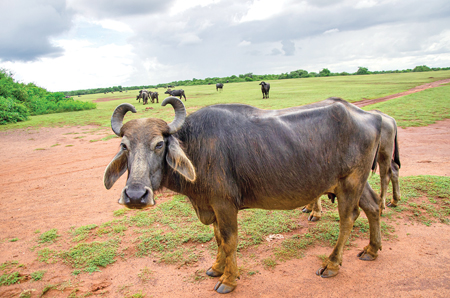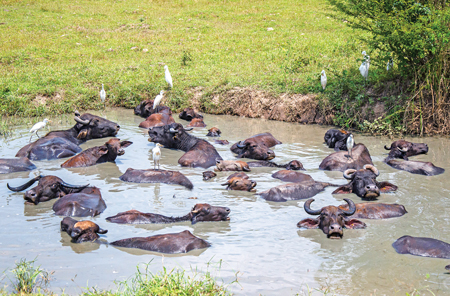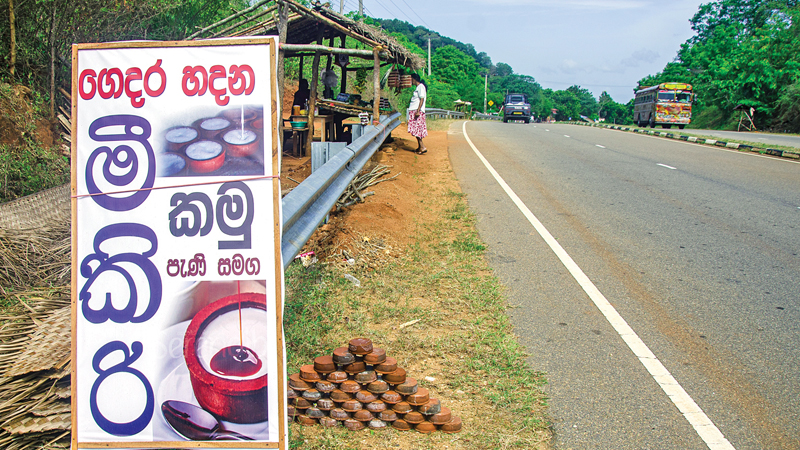 The production of the nutritious white creamy curd or Meekiri which is part and parcel of southerners as a food or ancient cottage industry is now big business.
The production of the nutritious white creamy curd or Meekiri which is part and parcel of southerners as a food or ancient cottage industry is now big business.
Here, I would like to reminisce an experience of mine relating to curd. One early morning, when I visited the Padikemgala Raja Maha Vihara in Migahajadura close to Mattala in the Hambantota district, the Chief Incumbent of the temple Ven. Lunama Gnanaloka Thera was having breakfast in the temple. So, I was asked to wait for some time. After breakfast, he invited me also to have breakfast which was brought to temple by villagers.

A wayside curd seller near Timbolketiya in Embilipitiya
He gave me a plate of ‘kurakkan thalapa’ with fresh curd and sugar (since no treacle was available at the temple). I have never eaten kurukkan thalapa with curd before and it was a little puzzle for me. Anyway, I had all together and indeed, it was amazingly delicious, a traditional dairy product revered for its rich creaminess and unique taste. Made from buffalo milk, this curd’s high-fat content gives it an unmatched texture that is both smooth and indulgent. The traditional method of preparation involves natural fermentation, which contributes to its distinct flavour and quality.
Buffalo curd is more than just a culinary delight in Sri Lanka; it is a vital part of the local economy, particularly in rural areas in the South and the East. Over 400 families in various villages depend on the production and sale of buffalo curd for their livelihoods. This traditional craft not only supports these families economically but also preserves a significant aspect of Sri Lankan culinary heritage.
Where the land is flat, and ocher-coloured, the air dry and almost cracking with heat, there may be found the water buffalo – wallowing in muddy waters, often just the curve of magnificent horns, slits of eyes and dark-grey nostrils visible. Inhospitable lands nudge man to make the most of whatever little there is. So here, buffalos, precious as ploughing machines of the paddy fields, are prized too for their milk and the curd it gives.
Huge herds

A curd stall beside the Lunugamvehera – Tissamaharama road
Early morning – when the air is cool, the heat simply a haze not yet risen off the land – sees huge herds ambling along the roadside. It’s milking time, and nowadays, the milk must be ready in its huge churns at designated collecting points.
You will see pots of curd hanging from the roadside stalls along the Southern inland and coastal roads, but particularly towards (and beyond) Hambantota. This is famous ‘curd’ country, and the title of ‘best curd’ is fiercely contested here. Pallemala near Bundala by others, but it is Ridiyagama, North of Ambalantota, Tissamaharama, Lunugamvehera and Thimbolketiya in Embilipitiya, which for years has been called, ‘The land flowing with milk and honey’.
This is Sri Lanka’s favourite dessert, and the honey or treacle, as it is often called, is a must as an accompaniment. From Kalutara to Beruwala, you will see ropes connecting the tops of the trees. Along these aerial walkways sway the ‘toddy trappers’, as they farm hectare after hectare of coconut palms. Toddy sap – from which the sweet, smoky treacle topping is distilled – is collected in earthenware pots, boiled and sweetened.
Eaten on its own, fresh buffalo curd is nutritious and healthy. But as a dessert, it must be accompanied by treacle. Of the several treacles produced in Sri Lanka, the finest comes from the giant fishtail palm known as kittul. According to local gourmets, this is the only acceptable variety to serve with the curd.

A herd of water buffaloes grazing on a lawn near Ambalantota
To indulge properly in this delectable dish, a chunk of curd should be gouged out of its pot with a large coconut-shell spoon and plopped into a bowl. Add kittul treacle, and the contents of the bowl will look like islands of hard cream in a lagoon of honey. Then gorge away. Do not blend the curd with the syrup; just consume it in good-sized chunks, sweetened but not totally overwhelmed by the treacle.
‘Meekiri’ or curd is the firmer, thicker, creamier and less-sour buffalo curd that has almost addictive qualities and is regarded by a few million Sri Lankans as the best possible dessert to follow mountainous meals of rice and curry. The hotter the curries are, the more welcome the delicious, cooling, soothing effect of curd and treacle.
It seems that the sturdy, and often truculent, water buffalos of the South and the East produce thicker, richer milk than what produced by most other categories. It is said that they drink less water, hence the thicker milk. Others say that since good fresh water is scarce in the drier parts, they are not able to dilute the buffalo milk as much as they would like.
On a more serious note, the finest curd is made by boiling the milk of a buffalo cow over a wood fire, then pouring it into a new, shallow clay pot, with just a dash of the previous day’s curd to start it off. Covered carefully and left in a dark, cool place, the milk curdles within 16 hours and is then lovingly covered with clean paper to be marketed in sets of two, four or more.
Tastes best

Water buffaloes wallow in mud near Tissamaharama
Curd must be eaten fresh before it gets too sour. The very best will have a visible top layer of creamy-coloured skin. The paler this skin, the fresher the curd beneath, which should be as firm as a good caramel custard, and unblemished white in colour. It should taste slightly sour and creamy with a faint and tantalising odour of good milk and fragrant wood smoke.
The dish tastes best of all if the curd is chilled and the treacle slightly warmed. This is the perfect combination.







